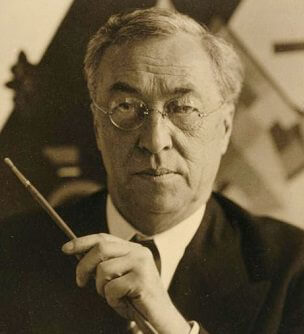The career of Wassily Kandinsky (1866–1944), a pioneer of modern art and theory, is a remarkable one. Trained as a lawyer in his native Russia, Kandinsky left behind a legal career and moved to the forefront of the European avant-garde in Munich and Paris. During a time of incredible scientific, industrial, and intellectual change, with the inventions of the automobile, the telephone, cinema, psychology, and the theory of relativity, Kandinsky invented a new language of art that expressed “inner necessity.”
 THE BEGINNINGS IN MUNICH
THE BEGINNINGS IN MUNICH
1896–1908
Wassily Kandinsky studied law for ten years before leaving Russia, and a promising legal career, in 1896 to become an artist in Munich. One of the avant-garde centers of Europe, Munich had a vibrant intellectual scene and was a haven for revolutionary artists.
Kandinsky absorbed Jugendstil (German Art Nouveau) and studied with several teachers, notably Franz von Stuck, before setting out on his own. In 1901, he founded the artist group Phalanx, through which he met his future companion, the painter Gabriele Münter. The tempera paintings he made during this time show the influence of Neo-Impressionism, as well as the development of an individual style: Russian themes explored with jewel-like color schemes that recall Russian icons. In 1906, Kandinsky spent a year in Paris, where he encountered art by Matisse and the Fauves, an experience that had a lasting impact on the artist.
MURNAU AND THE BLUE RIDER
1908–1914
This was a period of great experimentation and growth for Kandinsky, who spent much of his time in the Bavarian alpine town of Murnau. Gabriele Münter had purchased a home there, and Kandinsky had developed an interest in Bavarian folk painting on glass. His colleagues Marianne Werefkin and Alexei Jawlensky shared his interest, resulting in the four artists founding the New Artists Association of Munich.
Kandinsky was increasingly moving towards an art that expressed “inner nature,” moving closer to abstraction in highly symbolic works. He found a like-minded artist in Franz Marc, and in 1911, the two founded the Blue Rider group, which exhibited avant-garde European art. The next year they published the theoretical journal the Blue Rider Almanac. Kandinsky also published Concerning the Spiritual in Art (1911), one of the most important artist treatises of the twentieth century. But with the outbreak of World War I in 1914, Kandinsky returned to his native Russia and his trajectory was halted.
KANDINSKY IN RUSSIA
1914–1921
Kandinsky moved back to Russia in 1915 and later ended his relationship with Münter. These years of war, both World War I and the Russian Revolution, were difficult across Europe and Russia. Kandinsky had his property confiscated after the October Revolution in 1917 and suffered financial difficulties. He married Nina Andreevskaya during that same year and stayed with her in Achtyrka at a dacha (summer home) that was also later confiscated.
Kandinsky’s output was somewhat limited, in part due to deprivations and the lack of materials. Some of what he did produce on canvas was a return to Impressionism, which mirrored a broader return to the styles and order of an earlier age that occurred internationally due to World War I. He continued with his abstract paintings, but he disagreed with avant-garde Russian artists on the purpose of painting, which he felt should convey inner meaning. In the autumn of 1921, he was invited by the director of the Bauhaus, Walter Gropius, to visit Germany. This led to an eleven-year tenure with the Bauhaus.
JURYFREIE MURALS
Shortly after Kandinsky began teaching at the Bauhaus in 1922, where he was appointed Master of the Wall Painting Workshop, he was commissioned to produce murals for the annual Juryfreie Kunstschau (Nonjuried Art Exhibition) in Berlin. For Kandinsky, this was a chance to realize a dream: he had wanted to create a painted environment since seeing the colorfully painted interiors of Russian peasant homes. He embraced this as an opportunity for viewers “to stroll within the picture.”
Kandinsky prepared five gouache studies to serve as the basis for the designs, which Bauhaus students, including Herbert Bayer, helped transfer onto larger canvases. After the exhibition, the murals were lost. Kandinsky’s wife, Nina, supervised the re-creation of the murals, made using the extant gouache studies, for display in the lobby of the Centre Pompidou when it opened in 1977. This is their premiere exhibition in the United States.
KANDINSKY AND THE BAUHAUS
1921–1933
Kandinsky spent time in Berlin in 1921, recuperating from the privations of life in Russia, and then moved to Weimar in 1922 to teach at the Bauhaus. At this time, Kandinsky was highly regarded in Germany as a pioneering abstractionist and theoretician. At the Bauhaus, he joined an extraordinary faculty that included Josef Albers, Lyonel Feininger, Johannes Itten, Paul Klee, and Oskar Schlemmer. Their teaching program emphasized the direct handling of materials, experimentation, and a theoretical basis for understanding the principle elements of form.
In 1925, the Bauhaus was forced to leave Weimar by a conservative government and relocated to Dessau; here Wassily and Nina Kandinsky shared a detached double house, designed by Walter Gropius, with Paul Klee and his wife, and the artists became very close. Kandinsky lived with a Bauhaus aesthetic and painted his walls gray, pink, and black. This was a prolific period for Kandinsky, from 1926 to 1932: he painted numerous oils and watercolors, in addition to publishing his second major treatise, Point and Line to Plane (1926).
When the Nazis forced the closure of the Bauhaus in Dessau in August 1932, Kandinsky moved with the faculty to Berlin, where the Bauhaus existed briefly before closing permanently in 1933.
KANDINSKY IN PARIS
1933–1944
In 1933, Wassily and Nina Kandinsky moved to Neuilly-sur-Seine, a suburb of Paris recommended to them by Marcel Duchamp, who had once lived there. From his apartment overlooking the Seine, Kandinsky wrote to Alfred Barr, director of the Museum of Modern Art in New York: “When I moved to Paris I was so bowled over by light and nature.…Paris with its marvelous light (soft and intense) has softened my palette: there are other colors, other entirely new forms and some that I had not used for years.” Kandinsky’s lyrical paintings from this period demonstrate a new vocabulary of biomorphic forms inspired by the images of organisms he gleaned from scientific journals.
The rise of Nazism that caused the Kandinskys to move to Paris continued to affect the final years of the artist’s life. In 1937, Kandinsky’s paintings were included in Hitler’s infamous Degenerate Art Exhibition, which attempted to denigrate avant-garde European art. In the 1940s, it became increasingly difficult for Kandinsky to find canvas, so he painted on any support he could find, such as cardboard or wood panel. Despite this morose climate, his paintings are inventive, joyful, and full of humor.
Wassily Kandinsky died at his home on December 13, 1944, at the age of seventy-eight. In 1945, the Guggenheim Museum in New York organized a major retrospective to memorialize Kandinsky’s career. The exhibition traveled to the Milwaukee Art Institute, now the Milwaukee Art Museum.
